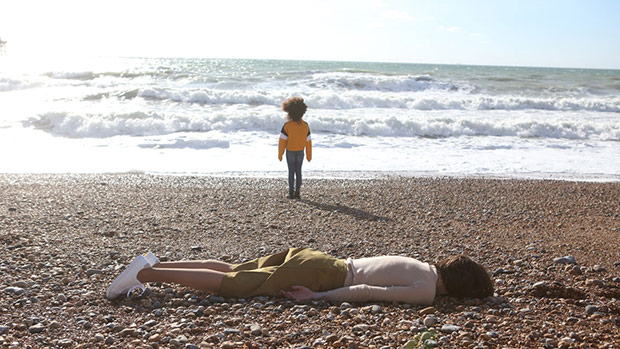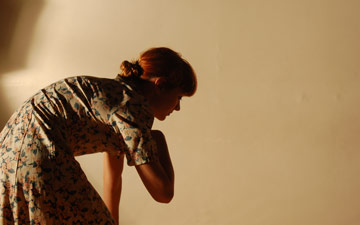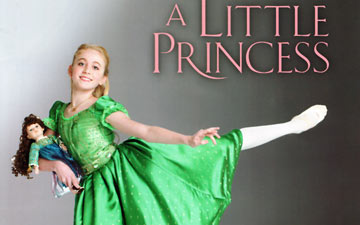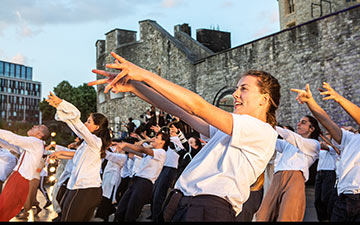
© Love Oh Love Photography. (Click image for larger version)
Fuel and Encounter
The Kids Are Alright
★★✰✰✰
London, The Place
10 April 2019
fueltheatre.com
encounterproductions.org
www.theplace.org.uk
A host of doubles are at play in this surreal and poignant work. To begin with The Kids Are Alright has been produced jointly by two companies: Fuel, an adventurous theatre company founded in 2004; and Encounter, which has a mission to fuse contemporary writing and dance, working with professional performers and amateur communities. This work was co-created by Jen Malarkey (director and choreographer) and Lee Mattinson (writer) and the key adult performances were another double-act between Carl Harrison (dressed as a woman, mostly playing a wife) and Anna Freeman (dressed as a man, mostly playing a husband).
This doubling continued with the sub-text of ‘two worlds on one stage’ in a pair of performances running simultaneously. While the adults played out three separate and over-lapping stories, seven children (aged around 9-11) ran around the stage in organised snatches of activity, apparently following instructions conveyed via noise-cancelling headphones. Occasionally, especially at the beginning of the 65-minute work, there seemed to be some interaction between the two sets of performers, if only in terms of the relative choreography of their movement patterns. However, as the work progressed, any semblance of such connection largely disappeared.
The main story revolved around bereaved parents who had lost their ten-year old daughter, Sophie, on a daytrip to the Natural History Museum, in London. Judging from impressive accents they had come from somewhere in the North of England. The gender reversal in terms of the actors playing these roles was immediately and lastingly effective: Freeman was pathetically real as the hapless husband desperately trying to both make a go of it with his impassive wife and keep the memory of Sophie alive; and Harrison was an electrifying presence as the mother, now a desiccated human shell but one who had been capable of bursting into dynamic movement at the merest hint of Whitney Houston. The descriptions of Sophie’s room as a shrine to her memory where the parents aimed to preserve her scent along with their memories were remarkably raw.
There were two other less-fledged stories, running parallel, with Harrison essaying a solo monologue as Chloe (Sophie’s childhood friend had been a Chloe) leaving London to visit York only to find that her messages remained unanswered from the “friend” she was visiting, leaving her to walk the streets alone with nowhere to go; and Freeman’s intermittent solo concerned a Texan’s search for a missing son: the name “Cody” being called out over-and-over with increasing desperation as the work ended.
Mattinson’s text and the meaningful performances of the two leads – both dressed in unappealing shades of beige and grey and wearing spectacles – held together an absorbing momentum. The narrative took us from Asda’s ham to the wife’s flirtation with a worker in B&Q (“he was very helpful”, says Harrison’s character, in mitigation) and on to an ill-fated, marriage-saving, cruise, intended to take in the Algarve (and a fantasy that Sophie had been sighted there) but ending with a cabin toilet that didn’t flush and the husband’s sudden desire to jump ship and drive home, across Europe, having adopted a stray dog, in Greece.
It was the brutal description of the destruction of said dog, after it had invaded Sophie’s room and defecated on her bed, that turned my stomach. It could have been dealt with in a less sickeningly graphic way. It was only after the event that I noted a small warning about this content in the promotional material and the recommendation that this work was for those aged 16+. My daughter is a 29-year-old dog lover and had she attended this show; I have no doubt that the horrific imagery (far too violent for me to describe here) would have given her nightmares for months to come.
The presence of the children – understandably excited and with at least one gesturing to friends or family in the audience – was, for me, a distraction that did nothing to enhance the work other than add more bodies on the stage. The programme promised that their participation project to create a Children’s Manifesto for Change would lead to them being heard in this ‘immersive story’, but apart from some brief recorded text at the beginning of the show, where the voiceover of one child spoke articulately about Rosa Parkes for a moment or two, there was no obvious visibility of this engagement.
Despite the excellence of the adult performances and the rawness of the emotions evoked by the text, I think that the idea of this “two worlds on one stage” didn’t in any way fulfil that remit. While the material was not suitable for kids, I would also argue that the kids were not alright for the material.

















You must be logged in to post a comment.